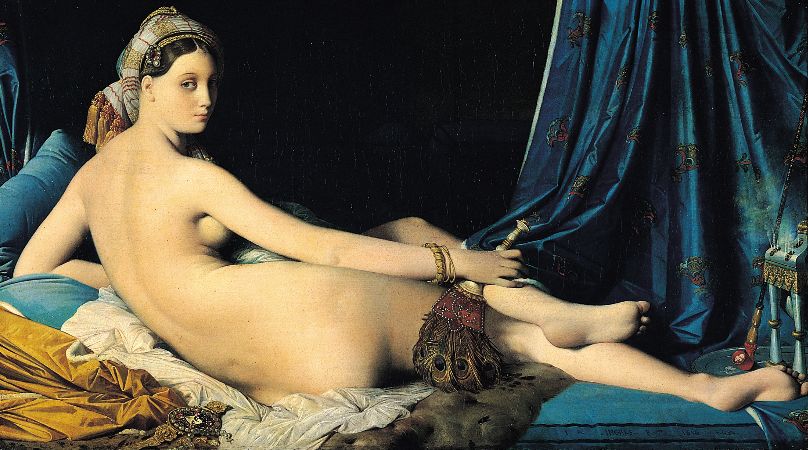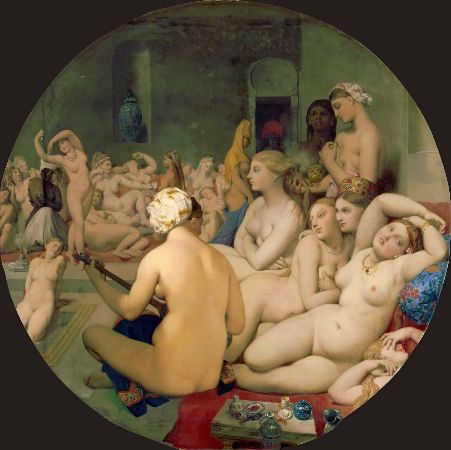The painter who dreams of a Turkish bath: Who is Jean Auguste Dominique Ingres
We often see nude female figures in many of Ingres' works, including Turkish Bath. He paints this work, which is exhibited in the Louvre Museum, based on the stories of Lady Mary Wortley Montague, the wife of the British ambassador who lived in the Ottoman Empire for a while.

Born in France on August 4, 1780, Jean Auguste Dominique Ingres is undoubtedly one of the most important artists of neoclassicism. Ingres, whose father is a sculptor and who took his first lessons from his father, earns money by working in the municipal orchestra while going to the Academy in the city where he was born.
Ingres, who was one of the few painters whose name was known while he was still alive, also took lessons from various painters and sculptors who were friends of his father. He came to Paris in 1796 and became a student of Jacques-Louis David, who would influence his art. He closely follows the art of antiquity and, like many other representatives of his style, even participates in Ancient Greek excavations and has the opportunity to examine many works, especially ancient sculptures. But he creates his style, especially by examining the works of Raphael.
Jean-Auguste-Dominique Ingres (29 August 1780 – 14 January 1867) was a French Neoclassical painter. Ingres was profoundly influenced by past artistic traditions and aspired to become the guardian of academic orthodoxy against the ascendant Romantic style. Although he considered himself a painter of history in the tradition of Nicolas Poussin and Jacques-Louis David, it is his portraits, both painted and drawn, that are recognized as his greatest legacy. His expressive distortions of form and space made him an important precursor of modern art, influencing Picasso, Matisse and other modernists.
In addition to portraits, he also paints large-scale religious, mythological, and historical paintings. Ingres, who is curious and wants to examine Roman art as well as ancient Greek art, attends various exhibitions while trying to save money for his trip to Italy. Thus, he attracted the attention of Napoleon Bonaparte and began to receive various orders from him.
Until 1806, the artist, who focused on portraits of himself and his friends with a simple linear expression with a romantic understanding, as well as the pencil portrait works of the noble class, which he made to earn money, later gained great value. These early works were defined by a calligraphic line and an expressive outline, and the principle that these lines give a certain sense of beauty in his works has remained valid throughout Ingres' entire artistic life.
La Grande Odalisque - The female figure with her back turned in the painting, which is considered to be one of his greatest works and is quite static, It would not be wrong to say that Ingres has a kind of weakness, even an obsession. This figure, which is seen in many of his works, shows anatomical defects.
Ingres' work called The Great Chamber, which is exhibited in the Louvre Museum in Paris, is shaped by the harmonious synthesis of the orientalist influences of the Eastern culture and the ideal beauty understanding that constitutes the artist's language of expression. Ingres has skillfully combined the casual look of the model, which creates a sense of lightness and carelessness, with the gaze of the viewer. In his work, Ingres preferred to use cool colors like mannerisms.
Ingres adheres to a certain understanding of beauty based on academic principles in the period when romanticism began to develop in France, but besides this, he also brings up situational qualities, especially in female figures. He created a sincere and soft atmosphere by using emotional expression in his portraits. He painted the figures shaped by the understanding of the beauty of the period, with an understated and plain expression. Therefore, he cared about the pattern and used color and light to serve the pattern.
In France, his works are not welcomed and admired with great enthusiasm. Thereupon, he returned to Italy in 1820, settled in Florence, and his oath of Louis XIII, commissioned by the Montauban Cathedral, was a great success.
Ingres, who will stay in Italy for many years, gets married. He also continues to paint portraits of his family and the various families he has commissioned. Ingres, who created a series of works containing the themes of the Middle Ages and Renaissance periods between 1814 and 1820, was also one of the pioneers of a new idealization of the Ancient Greek understanding of art.
In 1834, he became the president of the French Academy in Rome. Ingres, whose works were praised and gradually started to be recognized, returned to France in 1841 after many years, and this time he was greeted with great enthusiasm. Although Ingres' formalism and perfectionism are seen in the textures, the anatomical defects in the figures and the influence of Norwegian painting cannot be overlooked. This linearism is also seen in the works of Ingres, who says that line is the honor of art. After the dethronement of Napoleon and the gradual death of his family members, the artist devoted himself more to painting.

We often see nude female figures in many of Ingres' works, including Turkish Bath. He paints this work, which is exhibited in the Louvre Museum, based on the stories of Lady Mary Wortley Montague, the wife of the British ambassador who lived in the Ottoman Empire for a while. He was in his 80s when he sold the painting to Ottoman diplomat Halil Pasha. The work, which was rectangular when it was first made, was later transformed into a round form by Ingres. Therefore, it is thought that there may be two versions of the painting. The picture gives the viewer the feeling of watching through the keyhole. The work, which seems to be the disproportionate bodies of women, thickened lines in places, and a faulty drawing rather than a flaw, was declared the most erotic painting of the 19th century by Le Figaro Magazine.
Died on January 14, 1867, Ingres produced his works by adhering to a few specific themes throughout his artistic life, and the sensuality in his nude figures was interpreted in different ways by many critics.
